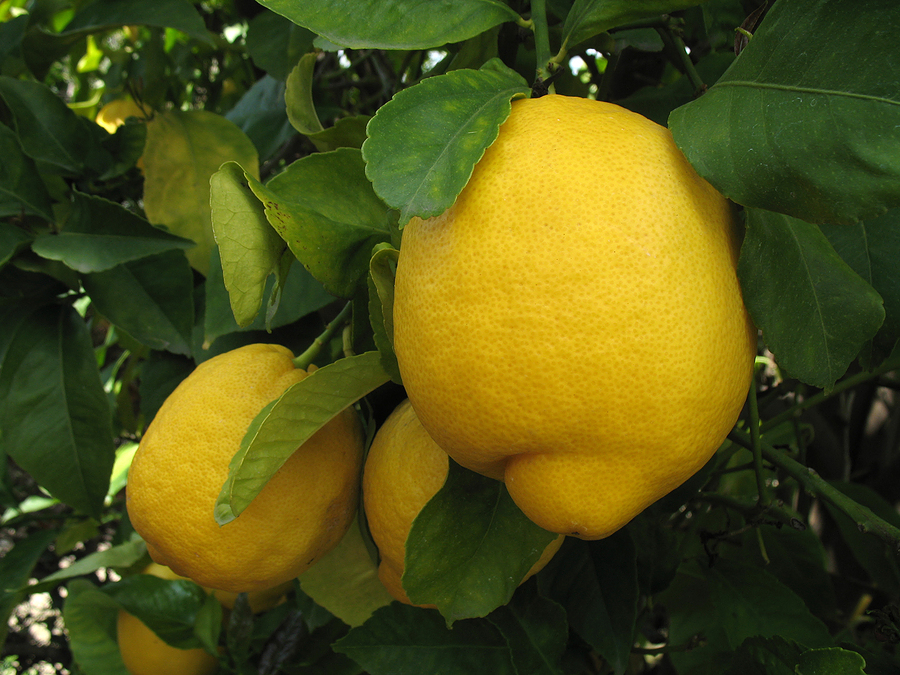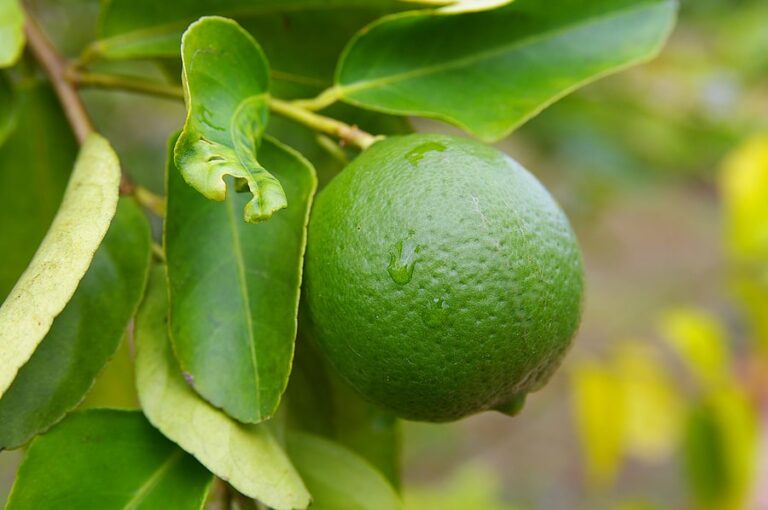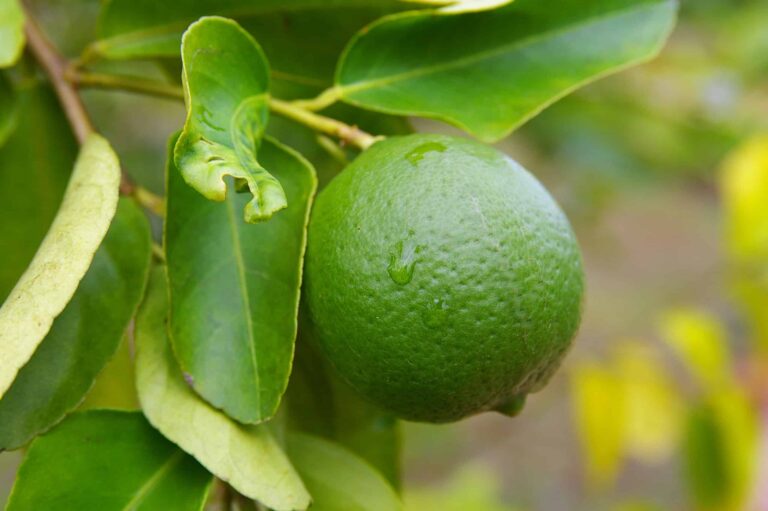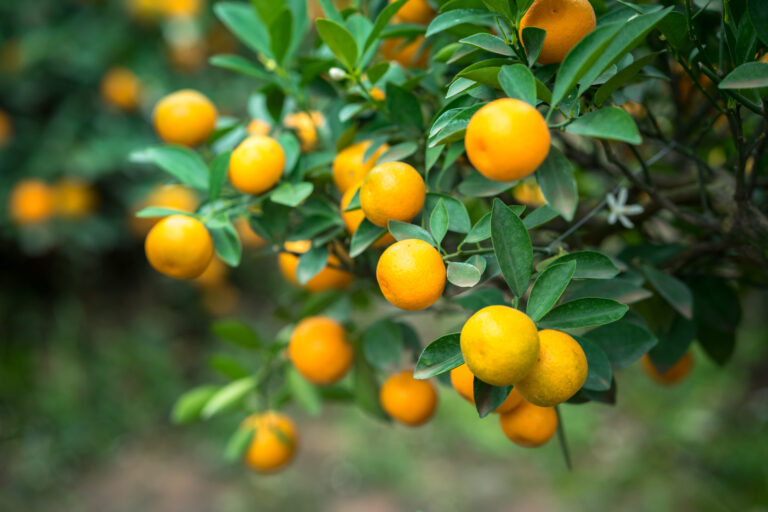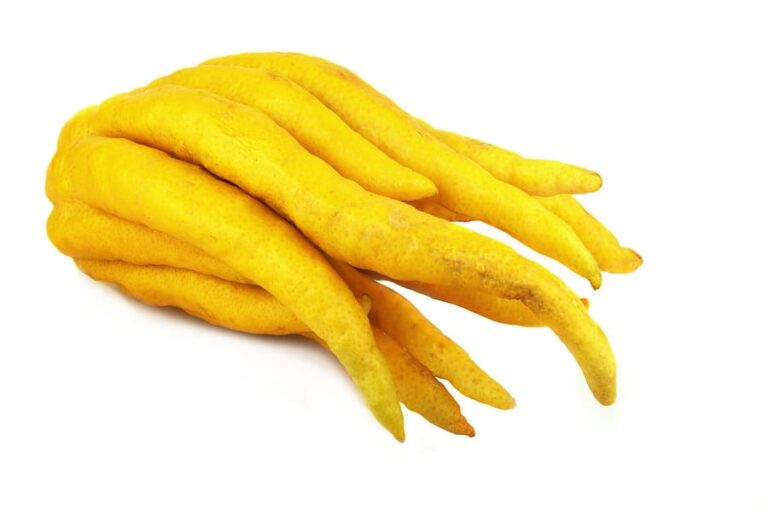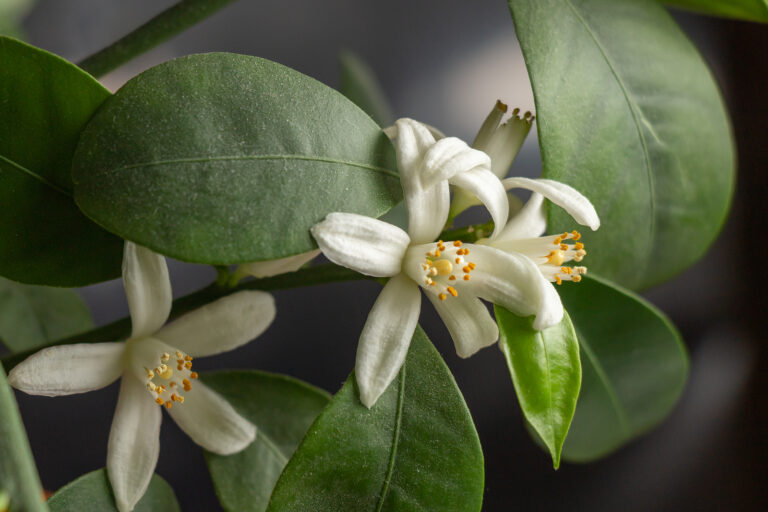How to Grow Lemon Trees in the Home Garden
Lemons have a low heat requirement and can be grown where sweet oranges and grapefruit won’t ripen. Lemon trees thrive in cool-summer areas of the citrus belt. They will even produce fruit indoors in northern cold winter regions. Lemon trees are well-suited to dry-summer regions.
Lemon trees are vigorous plants. They do not dwarf well. Expect a lemon to reach a mature height of 20 to 25 feet.
In mild climates, lemons blossom all year, and fruit in various stages of ripeness can be seen on the same tree throughout the year. In climates with intense heat, lemons tend to produce a single cross late in the year.
Related articles:
- Ways to Serve Oranges
- Ways to Serve Mandarin Orange
- Ways to Serve Lemons
- Ways to Serve Grapefruit
- Ways to Use Limes

Lemons are too tart to eat on their own, but they are probably used more than any other fruit. Lemons are the defining flavor in many desserts, and they add zest to just about all savory dishes.
Lemons grow where other citrus trees won’t. They have a lower heat requirement than sweet oranges and grapefruits. They thrive in the cool and dry summer regions of the West (they do less well in humid summer regions), and they can be grown indoors in cold-winter regions.
Lemons grow faster than other citrus trees. A lemon tree will begin producing fruit by the third year and will be fully productive in eight years.
More tips at How to Grow Citrus
A short history of lemon trees
There are many species and cultivars of lemons. All are hybrids between different citrus species; there is no one original lemon species from the wild. The common lemon was first cultivated in Pakistan and India. Lemons reached Europe in Medieval times. The lemon was introduced to the Americas by Columbus. Lemons were commonly cultivated in California by the mid-1700s. They are now grown throughout the world.
Best climate to grow a lemon tree
Lemons thrive in cool-summer regions, but not cold-winter regions. Lemons are more sensitive to cold than other citrus. Along coastal California lemon trees usually bear several crops a year; in warmer inland regions lemons are harvested fall through winter. Lemons grown in humid subtropical regions such as Florida are bigger than California lemons but not as flavorful. In hot humid climates, limes are a better choice. The acid content of lemon is at its maximum prior to fruit maturity.
True lemons such as ‘Eureka’ and ‘Lisbon’ will be damaged if temperatures drop below 30°F for prolonged periods. ‘Meyer’ lemon (a cross between a lemon and an orange) is hardier; ‘Meyer’ can withstand temperatures into the low 20sF.
Where to plant a lemon tree
- Plant the lemon tree in any warm, sunny spot sheltered from the wind.
- Choose the warmest spot in the garden; allow enough room for the tree to grow to its mature size. A standard-size tree will need 20 to 25 feet tall and wide.
- Roots will extend beyond the tree dripline so choose a place where neighboring roots will not interfere with growth.
- If planting in a lawn remove a 3- to 5-foot circle of lawn to eliminate competition from grass roots.
When to plant a lemon tree
- Planting time should allow for the longest period of mild or warm weather before extreme hot or cold temperatures; this will allow the plant to become established.
- In freeze-prone areas, plant in late winter or early spring after all danger of frost is past. In hot summer regions, plant in the fall; this will allow the tree to become established before very hot weather.
- Plant in autumn in normally frost-free regions.
How to plant a lemon tree
- Dig a hole deeper than the root ball and twice as wide. Rough up the sides of the hole to let the roots grow out more easily.
- Do not amend the backfill or add fertilizer to the bottom of the hole; feed the tree only when it starts to produce new growth.
- Carefully lift the tree from its container; avoid jerking the tree from the container.
- Straighten out any circling roots; cut away broken roots.
- Plant the tree at the same level or slightly higher as it grew in the container; the color of the trunk will tell you where the previous soil level was.
- Pack soil gently around the root ball eliminating air pockets.
- When the hole is half full, fill it with water to settle the soil. Once the water has soaked in, finish packing the soil to the top of the hole and water again.
- Create a watering basin around the newly planted tree; use garden soil about 6 inches high and wide; you can form an inner wall – creating a donut shape – to keep water away from the trunk.
Lemon tree spacing
- Space lemon trees 16 to 20 feet apart.
Lemon tree pollination and flowering
- Lemons are pollinated by bees and other insects. Lemons are self-fertile and have a good fruit set, You only need a single tree to get fruit.
- Many lemon blossoms are sterile and so produce seedless fruit.
- Lemon flowers are white with reddish buds, Flowers can be solitary or borne in clusters.
- A single tree can produce a few dozen to several hundred fruits in one year.
Planting a lemon tree in a container
Lemons can be grown in 10 or 15-gallon containers. Set the container on a plant trolley with wheels so that it can be moved to warm, sunny spots or brought indoors in winter. Use a commercial potting mix formulated for citrus or acid-loving plants. Grow lemons outside during the frost-free months; when night temperatures drop to the mid-40sF move lemons in containers indoors.
Indoors, lemons need as much light as possible. Grow lemons in a south-facing window or provide supplemental light.
‘Meyer’ lemons are a good choice for container and indoor growing. Meyer lemons are naturally small, easy to grow, and bloom and fruit almost constantly.
- Both standard and dwarf citrus trees can be grown in containers. Because roots will be restricted in a container, the plant will grow smaller than it would in the ground.
- A container at least 18 inches across should be sufficient for several years.
- Make sure the container has drainage holes. Keep in mind, that moisture evaporates faster from porous pots than nonporous ones, necessitating more frequent watering.
- A wheeled base such as a dolly will make it easier to move the plant to protection during cold weather.
- Plant in light, well-drained potting mix. Do not mix fertilizer into the soil.
- Set the plant at the level it grew in the original pot.
- Allow e or 3 inches at the top of the container for water.
- Firm the soil around the root ball and then water thoroughly.
Lemon tree container culture – indoor growing
- Keep the soil evenly moist for potted trees. Use a moisture meter or test the soil with your finger whenever the soil feels dry.
- Water potted trees by pouring over the soil until water flows out the drainage holes.
- Don’t let the plant sit in a saucer full of water.
- Because container plants are watered so often. Fertilizer may be washed away quickly. Use a slow-release fertilizer that will not wash away with each watering.
- Move potted citrus indoors if a freeze is predicted.
- Citrus grown indoors needs bright light. Place the plant near a sunny window but away from radiators or heat sources.
- Sudden changes in temperature can result in leaf and fruit drop.
- The ideal humidity level for indoor citrus is about 50 percent. Overly dry air can result in leaf drop.
Watering a lemon tree
- Citrus is evergreen and needs water throughout the year.
- Water to keep the soil moist, but not wet.
- Water when the top few inches of soil are dry; use a moisture meter to determine how moist the soil is.
- Water the root system but keep the trunk and bud union dry.
- Deliver water to the roots by flooding a basin above the tree root zone or use drip irrigation. Irrigation should wet the entire root zone. Expand the watering area as the tree grows.
Feeding a lemon tree
- Feed citrus with a citrus food high in nitrogen such as 10-5-10.
- A slow-release organic fertilizer will feed the plant throughout the year.
- Always follow package instructions on the amount and frequency of feeding.
- Feed citrus trees after they put on new growth.
- A nitrogen deficiency can result in leaves turning yellow; apply a high-nitrogen fertilizer.
- A zinc deficiency can result in abnormally small leaves with yellow blotches between the veins; this can occur in alkaline soils. Treat the tree with a foliar spray.
- An iron deficiency can result in young leaves gradually turning yellow between the veins. This can occur in alkaline soils that are poorly drained. Add a chelated iron to the soil.
- A manganese deficiency can occur along with a zinc or iron deficiency; young leaves turn a light green between the veins. Apply a foliar spray.
- A magnesium deficiency can cause older leaves to turn yellow between the veins. Apply a foliar spray or add magnesium sulfate to the soil.
Lemon tree routine care – weeding, mulching
- Mulch around citrus to eliminate weeds which compete for water and nutrients.
- Mulch will keep roots cool and conserve soil moisture in hot weather. Remove mulch if a freeze is forecast; bare soil absorbs more warmth than mulch.
- Compost and leaf mold are suitable organic mulches.
- Keep mulch back from the tree trunk by about a foot to discourage rot.
Thinning and pruning a lemon tree
Lemon trees require more pruning than other citrus trees. They naturally make long stems that are easily broken under the weight of fruit. Stems constantly crisscross the center of the plant; the results are small fruits and more difficult harvests. Stems should be thinned and shortened regularly. Prune back weak shoots to a strong lateral branch. A lemon tree also should be top pruned to allow light to reach ripening fruit. A lemon tree that is regularly lightly pruned will produce more fruit than a tree that goes unpruned or a tree that is heavily pruned.
True lemons such as ‘Eureka’ and ‘Lisbon’ can reach 20 feet tall. ‘Meyer’ lemon (which is a lemon-orange hybrid) grows to just 10 feet tall. A lemon tree should be headed back regularly to keep the tree compact and the fruit within reach. Prune lemon trees once or twice a year.
- Lightly pruned lemon trees produce more fruit than either unpruned or heavily pruned ones. Prune lemon trees once or twice a year throughout their life.
- In freeze-prone areas, avoid pruning in fall or winter; pruning can stimulate new growth that can be damaged by cold.
- Snip off suckers (rootstock growth) below the bud union on the trunk or underground. Root suckers will not bear the same fruit as the scion above the bud union.
- Shoot growth is more vigorous on the lemon than other citrus. Shoot growth must be trimmed away. Prune shoots back to the lateral.
- Remove watersprouts—upright growing shoots that appear on branches or in branch crotches.
- If a lemon tree becomes choked with inner branches, the fruit can be small and scarred.
- Remove growth that makes the tree lopsided.
- Prune away dead or broken branches.
- Remove dead wood and unproductive twigs and stems; this will allow light and air into the center of the tree.
- Remove the upper limbs if the tree grows too tall.
- Allow branches to grow close to the ground in intensely sunny regions. The low growth will protect the bottom branches from sunburn and give a bigger harvest.
- In humid regions, trim up lower branches to improve air circulation and deter diseases.
Lemons tree pest controls
- Control ants with a sticky band on the trunk or use soap spray or ant baits.
- Remove aphids with a strong jet of water or apply soap or oil sprays.
- Remove mealybug cottony masses by hand or hose them off with water or apply soap or oil sprays.
- Mites can attack citrus that is underwatered.
- Scale insects can be suffocated with an oil spray.
- Handpick, trap, or bait slugs and snails.
Lemon tree disease controls
- Black rot and fungal diseases caused by rainy weather can be prevented if copper fungicides are applied early enough.
- Greasy spot fungal disease can occur in hot, humid climates; spray the tree with an oil or copper fungicide.
- Fruit brown rot can occur if fungal Phytophthora spores splash on the lower part of the tree; this can cause brown spots on the rind. Prune to improve air circulation.
- Foot rot or gummosis is caused by a Phytophthora infection; sap oozes from cracks. A systemic fungicide may treat the disease.
- Sooty mold feeds on the excrement of aphids and mealybugs; hose off sap suckers
Lemon tree environmental problems
- Trees that are alternate bearing can be thinned in heavy fruit crop years.
- Flower and fruit drop can occur if the tree has more flowers or fruit than it can support.
- Fruit splitting can occur if watering is irregular.
- Regreening can occur if ripe fruit remains on the tree during hot weather.
- Sports—leaves or fruit of a different color or shape—can occur occasionally.
- Cold damage can cause leaves and twigs to appear watersoaked. Remove damaged wood and fruit when temperatures moderate.
- Excessive fruit drop can be caused by sudden changes in temperature.
- Sunburn of stems and branches can occur in hot-sun areas; wrap the trunk with paper or cardboard bands.
- Wind damage can occur if trees are not protected from hot, drying winds.
Lemon propagation
- Common lemons can be grown from seed. Cross-pollinated seeds will produce variable progeny.
- The ‘Meyer’ lemon is reproduced by cuttings; plants grown from cuttings will bear fruit in 2 to 3 years.
How to harvest lemons
Pick lemons when they become fully yellow; left too long on the tree they will lose flavor and acidity and become pithy. Fruit can be harvested as soon as it is plump and juicy even if the rind is green; a lemon that is not fully yellow will be more acidic and store longer.
- Citrus ripens only on the tree, not after being picked.
- Ripeness is not always reflected in rind color; the best way to tell if citrus is ripe is to pick a sample and try it.
- Fruit will hold on the tree and can be picked as you need it.
- Harvest the entire crop if a freeze is predicted; put the crop in cool storage.
- Harvest citrus by giving it a quick twist as you pull it or by clipping the stem with a hand pruner. Pulling fruit from the tree can result in broken branches or fruit that leaves some rind behind on the stem.
Storing lemons
- Ripe lemons will keep on the tree.
- Lemons can be kept for six to eight months after picking if they are cured during dry weather. Keep the fruit at a temperature of 50° to 60°F. During storage, the rind loses moisture and becomes tougher and more resistant to injury.
Lemons kitchen use
- Lemons are grown mostly for their juice. They are used in lemonade, as a garnish for fish or meats, and in pies, cakes, saucers, candies, jams, and jellies.
- Lemon peel is candied and used in marmalade.
- Lemons can be used for pectin.
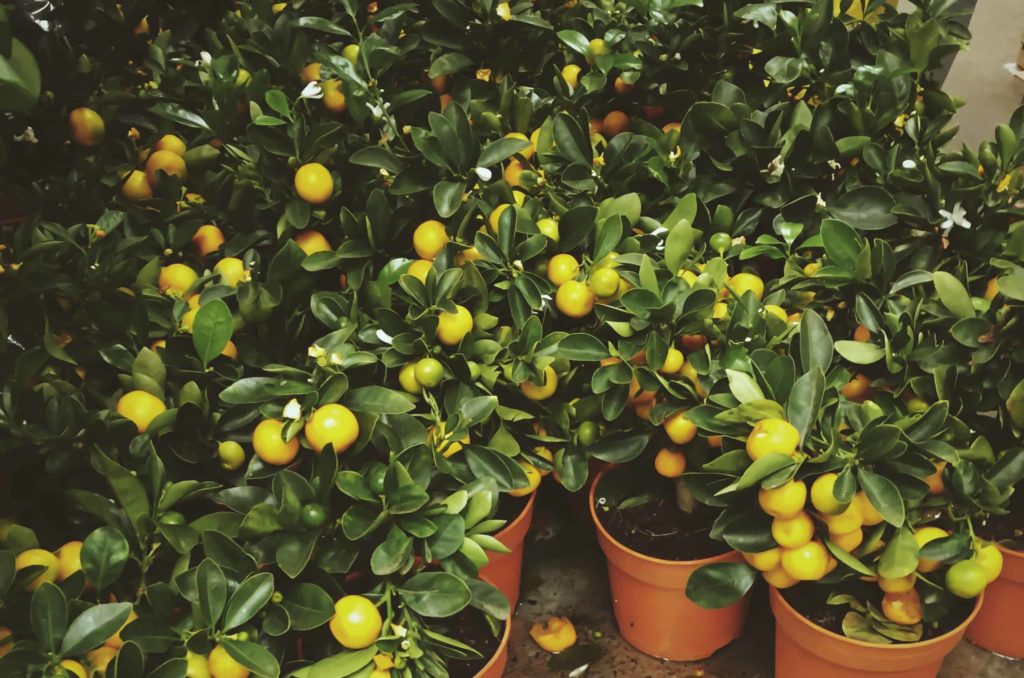
Lemon varieties for home gardens
- ‘Eureka’: produces a medium-sized, oblong fruit thick with a yellow rind and few seeds; ‘Eureka’ has a nipple at one end; the flesh is juicy and highly acidic; the fruit is hard to peel. ‘Eureka’ is a medium-sized, thornless tree; it has an open and spreading habit. It is smaller than the ‘Lisbon’ lemon. ‘Eureka’ lemons produce fruit all year in cool summer regions; in hot regions, ‘Eureka’ produces fruit in spring and summer. ‘Eureka’ is less hardy than ‘Lisbon’; it is adapted to mild-winter coastal areas of California; near the coast, the fruit is ripe in late winter to early spring; inland, harvest comes twice a year in spring and again in fall.
- ‘Improved Meyer’: ‘Meyer’ is a sweet orange-lemon hybrid. ‘Meyer’ lemons are medium size and round, with an orange-yellow thin skin when mature; there are few seeds. ‘Meyer’ flesh is light to dark yellow, very juicy, mild, and slightly sweet; it has a higher sugar content than other lemons; it has a distinctive flowery fragrance and flavor; left on the tree ‘Meyer’ loses acidity. ‘Meyer’ is a small to medium-sized tree, thornless; it is hardy and can withstand temperatures to the mid-20sF, colder than true lemons; the tree is compact and rarely grows more than 8 to 10 feet tall. In cool summer climates such as the coast of California, ‘Meyer’ lemons are very productive; they will bloom and bear fruit almost year-round. The ‘Improved Meyer’ replaced the ‘Meyer’; ‘Improved Meyer is disease-resistant. In humid summer climates like Florida true lemons are subject to disease and produce poor-quality fruit; the alternative is to plant an ‘Improved Meyer’.
- ‘Lisbon’: medium-size with fruit with bright yellow rind and few seeds; thick skin is hard to peel; moderately juicy, highly acidic flesh; best picked ripe; fruit loses acidity on the tree. ‘Lisbon’ is a large tree with thorns, more vigorous and productive than ‘Eureka’; it is both frost tolerant and heat tolerant; the new growth and flowers are tinged with purple; fruit ripens fall to winter inland and year-round in coastal regions; frost tolerant and heat tolerant; acceptable for cooking and baking; can be grown indoors; a natural dwarf
- ‘Ponderosa’: lemon-citron hybrid; grapefruit-size fruit up to 2 pounds; thick, bumpy, rind, very hard to peel; moderately juicy, acidic pulp; fruit holds well on the tree; small thorny tree, blooms all year; sensitive to frost; grows well in containers.
- ‘Variegated Pink Eureka’: light pink flesh, sometimes sold as ‘Pink Lemonade’ but the juice is not dark very tart, and nearly seedless; the pinker the pulp the less acidic the flavor. A sport of ‘Eureka’; leaves and fruit are variegated–green and white foliage, lemons are green-striped when immature; stripes fade as the fruit ripens to yellow; does not need intense heat or cool nighttime temperatures to develop color; can harvest the fruit when it has the flavor you want.
Also of interest:
Eureka Lemon and Lisbon Lemon: Kitchen Basics
Sweet Meyer Lemon: Kitchen Basics
Related articles:
Planning the Home Fruit Garden
Garden Planning Books at Amazon:
- Vegetable Garden Almanac & Planner
- Kitchen Garden Grower’s Guide Vegetable Encyclopedia
- Vegetable Garden Grower’s Guide
- Tomato Grower’s Answer Book
More fruit-growing articles:
Learn how to plant, grow, prune, and harvest your favorite fruits. Click below for all you need to know.
- Apple
- Apricot
- Avocado
- Banana
- Blackberry
- Blueberry
- Cantaloupe
- Chayote
- Cherimoya
- Cherry
- Citrus
- Clementine
- Cranberry
- Currants
- Elderberry
- Feijoa
- Fig
- Gooseberry
- Grape
- Grapefruit
- Guava
- Kiwifruit
- Kumquat
- Lemon
- Lime
- Loquat
- Mandarin
- Mango
- Melon
- Mulberry
- Muskmelon
- Nectarine
- Olive
- Orange
- Papaya
- Passion Fruit
- Peach
- Pear
- Persimmon
- Pineapple
- Pineapple Guava
- Plantain
- Plum
- Pomegranate
- Pumpkin
- Quince
- Raspberry
- Strawberry
- Tangelo
- Tangerine
- Tangor
- Watermelon

